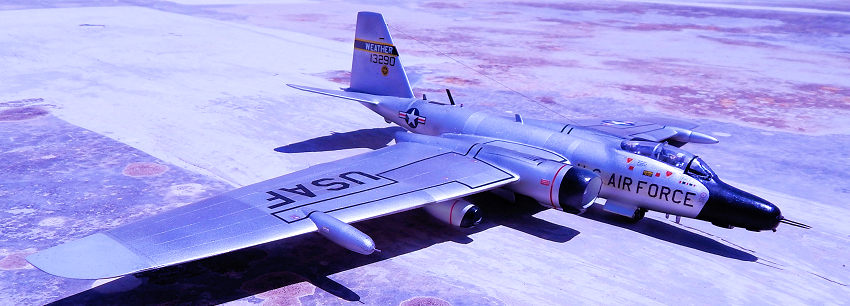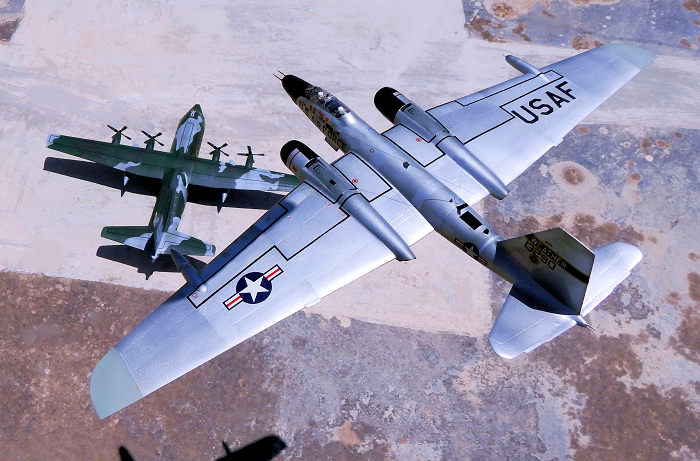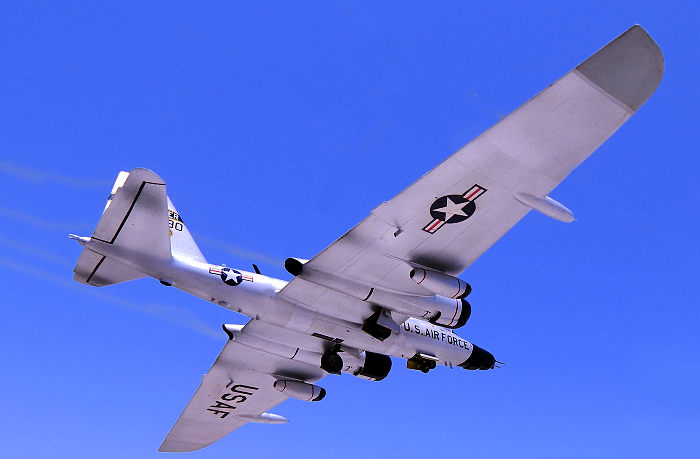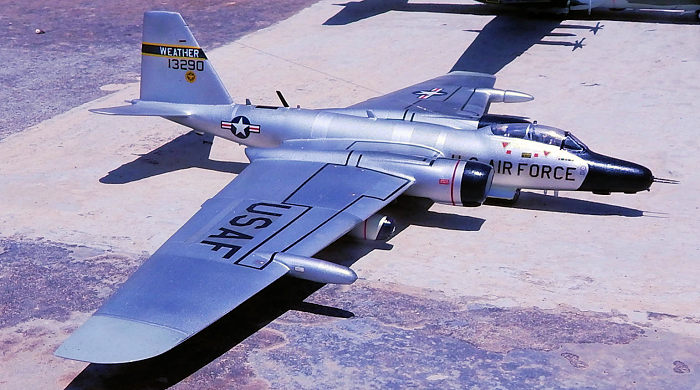
| KIT #: | 190 |
| PRICE: | 11 Euros |
| DECALS: | None supplied |
| REVIEWER: | Carmel J. Attard |
| NOTES: | Vacuform |

| HISTORY |
The RB-57F was developed as a result of an Air
Force Big Safari
requirement for a high-altitude reconnaissance platform with better performance
than the existing and similar RB-57D, some of which had been grounded as a
result of wing spar failures. A more urgent need to field an aircraft capable of
high altitude signals intelligence arose in 1962 when a SIGINT operation
conducted by United States Navy against the Soviet Union from Peshawar,
Pakistan, ended abruptly because the Pakistani government evicted the Navy for
committing too many violations of restricted airspace.
 Two B-57Bs dubbed "Pee Wee
1" and "Pee Wee 2" were quickly modified by
Big Safari
with antennas and a modular telemetry receiver suite packaged in a pressurized
canister and sent to Pakistan in January 1963 as an interim measure under an
operation named Little Cloud
to continue the mission. In the meantime
Big Safari authorized the
Pee Wee III
project to develop the new high-altitude platform from existing B-57s. Because
General Dynamics was responsible for contract maintenance on the D model, its
Fort Worth Division was given the sole-source contract for the development of
the Pee Wee III
RB-57F prototypes.
Two B-57Bs dubbed "Pee Wee
1" and "Pee Wee 2" were quickly modified by
Big Safari
with antennas and a modular telemetry receiver suite packaged in a pressurized
canister and sent to Pakistan in January 1963 as an interim measure under an
operation named Little Cloud
to continue the mission. In the meantime
Big Safari authorized the
Pee Wee III
project to develop the new high-altitude platform from existing B-57s. Because
General Dynamics was responsible for contract maintenance on the D model, its
Fort Worth Division was given the sole-source contract for the development of
the Pee Wee III
RB-57F prototypes.
The RB-57F Canberra was a Convair development of the Martin B-57 which
originated from the English Electric Canberra.The prototype RB-57Fs incorporated
many major changes from the immediate predecessor RB-57D, the most obvious of
which was a more enlarged and computer-designed wing to enable it to operate at
extreme altitudes. The wing had a span of more than 122 feet (37 m), which was
16 feet (4.9 m) longer than the RB-57D and nearly twice the length of the B-57B
fuselage on which it was installed. Extensive use was made of aluminum honeycomb
wing panels in the wings that bonded outer and inner aluminum skins to a
honeycomb of aluminum and fiberglass. All control surfaces had tightly sealed
gaps in order to reduce drag, and there were no wing flaps. In addition, the
size of the empennage was redesigned so that the vertical stabilizer had nearly
twice the area of that of the standard B-57B. Its height was increased to 19
feet (5.8 m) and the width increased, improving lo ngitudinal and asymmetric
control for greater stability at very high altitudes (up to 80,000 feet
(24,000 m).
ngitudinal and asymmetric
control for greater stability at very high altitudes (up to 80,000 feet
(24,000 m).
Another obvious change was the replacement of the Wright J65 turbojets with Pratt & Whitney TF33-P-11turbofan engines. The TF33s gave the aircraft more than double the thrust of the B model. The RB-57F was also fitted with two detachable Pratt & Whitney J60-P-9 turbojets mounted in pods attached to the wings outboard of the main engines. These auxiliary engines were air-started and only for use at altitude in flight. At altitudes above 40,000 feet (12,000 m), the J60s generated about 3,300 pounds-force (15 kN) of thrust each and increased the maximum altitude of the RB-57F by 2,000–3,000 feet (610–910 m).
Military Air Transport Service (and its successor organization Military Airlift Command) was frequently used by the USAF for clandestine, special operations missions prior to the establishment of Air Force Special Operations Command in the 1980s. The RB-57F, with its extreme high-altitude ceiling was frequently used as a strategic reconnaissance platform. The four Rivet Slice aircraft (converted from RB-57D airframes) were equipped with covertly mounted cameras and assigned specifically to reconnaissance work in 1965, Rivet Slice 2 and 3 with the 6091st Reconnaissance Squadron at Yokota AB and Rivet Slice 1 and 4 with the 7407th Support Squadron at Rhein-Main AB
The official mission of the RB-57F was weather reconnaissance, and all RB-57Fs were assigned to meteorological units of the 9th Weather Reconnaissance Wing Air Weather Service, Military Air Transport Service, headquartered at McClellan Air Force Base, California:
55th Weather Reconnaissance Squadron, McClellan AFB, California
56th Weather Reconnaissance Squadrion, Yokota AB, Japan
57th Weather Reconnaissance Squadron, Avalon Airport, Avalon, Victoria, Australia
58th Weather Reconnaissance Squadron, Kirtland AFB, New Mexico.
 Air Weather Service RB-57Fs duties involved high-altitude atmospheric
sampling and radiation detection work in support of nuclear test monitoring,
mostly on behalf of the Atomic Energy Commission including collection of
airborne debris in a program of ongoing monitoring of nuclear tests. Most of
this activity was centered on nuclear tests carried out in People's Republic of
China, but monitoring air in the aftermath of U.S. underground nuclear tests was
also conducted. One RB-57F is known to have been used for research into airborne
laser equipment by the Air Force Logistics Command research laboratory at
Kirtland AFB. In 1968, the Air Weather Service's RB-57Fs were redesignated
WB-57F.
Air Weather Service RB-57Fs duties involved high-altitude atmospheric
sampling and radiation detection work in support of nuclear test monitoring,
mostly on behalf of the Atomic Energy Commission including collection of
airborne debris in a program of ongoing monitoring of nuclear tests. Most of
this activity was centered on nuclear tests carried out in People's Republic of
China, but monitoring air in the aftermath of U.S. underground nuclear tests was
also conducted. One RB-57F is known to have been used for research into airborne
laser equipment by the Air Force Logistics Command research laboratory at
Kirtland AFB. In 1968, the Air Weather Service's RB-57Fs were redesignated
WB-57F.
| THE KIT |
 Released by Airmodel Products, the Kit consists essentially of 26 vac
form parts molded on white styrene. No decals are issued but there is a good
reference side view to help one fork out the required decals appropriate for one
example in ‘Weather Service markings’ The two page instructions consists of a
very brief history of the high altitude aircraft, an exploded view depicting the
essential main parts issued, less the 4 part engine cowlings which for some
unknown reason were omitted. Section bulkheads are also not supplied not even a
drawing of the sections required are given.. I am assuming this model was a long
out of production kit and therefore difficult to acquire.
Released by Airmodel Products, the Kit consists essentially of 26 vac
form parts molded on white styrene. No decals are issued but there is a good
reference side view to help one fork out the required decals appropriate for one
example in ‘Weather Service markings’ The two page instructions consists of a
very brief history of the high altitude aircraft, an exploded view depicting the
essential main parts issued, less the 4 part engine cowlings which for some
unknown reason were omitted. Section bulkheads are also not supplied not even a
drawing of the sections required are given.. I am assuming this model was a long
out of production kit and therefore difficult to acquire.
| CONSTRUCTION |
After separating the parts from the styrene sheet, the aircraft is
assembled into minor sub assemblies. Parts are scored with a sharp exacto blade
and then snapped from the backing sheet. First the fuselage and wing centre
sections are sanded and interior detail as cockpit office to forward fuselage
and cross section brackets are added to the centre section. With the use of a
profile gauge I was able to get the shape of four separate section bulkheads
required to strengthen the fuselage from inside. The sub assemblies are
carefully painted on the inside and glued together. This is followed by outer
wing panels. The tail plane halves were out of shape and instead I cast a set of
tail planes in aluminium using ones from an Italeri kit as patterns. After
glueing these together the outer wing panels and horizontal ta il surfaces are
added. As the model was tail heavy adequate amount of nose weight was placed at
the front nose compartment
il surfaces are
added. As the model was tail heavy adequate amount of nose weight was placed at
the front nose compartment
I much prefer erred to use parts from a Canberra B6, Airfix kit for undercarriage legs, main wheels and nose wheels and well doors. I have reshaped the engine cowlings and again preferred to cast a set of cowlings in aluminium, making them hollow on the inside. I then added the turbo fan blades from surplus kit parts with a cone at centre. Continual reference to scale plans and photos of the aircraft being built was essential. I also reshaped the kit wing outer sampling pods which differed from each other. The auxiliary engines which are located outboard of the main engines were assembled in the end.
Kit represents one of the last WB-57F of 58 WRS based at Kirtland AFB, New Mexico.
All interiors like main wheel wells and nose well were painted chrome yellow and the fuselage was essentially silver overall with a variety of silver on paneling . Areas to nose, engine cowlings, engine fronts were painted black with a coat of matt varnish. Outer wing panels were light aircraft gray (FS 16473). Wing walk ways were made in black decal strips. Lettering and USAF insignia were all Super Scale decals.
| CONCLUSIONS |
This kit provided the basic parts but the end result is quite far from the original shape of parts. It was essential to acquire and make use of scale plans for the kit since these were not provided and on top of that some scratch building was a paramount issue to arrive close enough to an RB-57F that I was aiming for. Kit is definitely not recommended to those that go for OOB kits but for anyone with an eagerness to make something unusual with a vac kit that may happen to comes his way.
2 June 2017 Copyright
ModelingMadness.com If you would like your product reviewed fairly and fairly quickly, please
contact
the editor or see other details in the
Note to
Contributors.
Back to the Main Page
Back to the Review
Index Page
Back to the Previews Index Page